Earth:Fort Union Formation
| Fort Union Formation Stratigraphic range: Maastrichtian-Selandian (Lancian-Clarkforkian) ~66–58 Ma | |
|---|---|
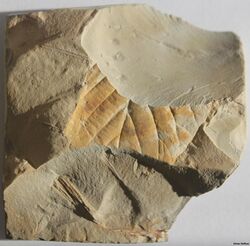 Fossils from the Fort Union Formation | |
| Type | Geological formation |
| Sub-units | Atwell Gulch, China Butte, Ekalaka, Lebo, lower Ludlow, Overland, Rock Bench Quarry, Sentinel Butte, Shotgun, Somber beds, Tongue River, Tullock, upper Ludlow, Polecat Bench Formation |
| Underlies | Wasatch Formation |
| Overlies | Hell Creek Formation, Lance Formation |
| Lithology | |
| Primary | Sandstone, shale |
| Other | Coal |
| Location | |
| Region | Montana, North Dakota Wyoming, Colorado |
| Country | |
| Extent | Powder River Basin |
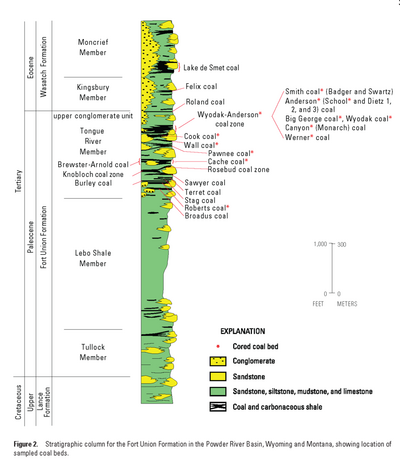
The Fort Union Formation is a geologic unit containing sandstones, shales, and coal beds in Wyoming, Montana, and parts of adjacent states. In the Powder River Basin, it contains important economic deposits of coal, uranium, and coalbed methane.[1]
Description
The Fort Union is mostly of Paleocene age and represents a time of extensive swamps as well as fluvial and lacustrine conditions. The rocks are more sandy in southwestern Wyoming and more coal-bearing in northeast Wyoming and southeast Montana, reflecting a general change from rivers and lakes in the west to swamps in the east, but all three environments were present at various times in most locations.[2]
Coal in the Fort Union in the Powder River Basin occurs mainly in the Tongue River Member, where as many as 32 coal seams total more than 300 feet in thickness.[1] One such bed, the Wyodak Coal near Gillette, Wyoming, is as much as 110 feet (34 m) thick. Most of the coals in the Fort Union Formation are ranked subbituminous.[3]
Fossil content
Mammals
Cimolestans
| Cimolestans reported from the Fort Union Formation | ||||||
|---|---|---|---|---|---|---|
| Genus | Species | Locality | Stratigraphic member | Material | Notes | Images |
| Crustulus | C. fontanus | Northeastern Montana.[4] | Tullock Member.[4] | An isolated upper molar.[4] | A pantodont. | |
Leptictids
| Leptictids reported from the Fort Union Formation | ||||||
|---|---|---|---|---|---|---|
| Genus | Species | Locality | Stratigraphic member | Material | Notes | Images |
| Prodiacodon | P. crustulum | Garfield & McCone counties, Montana.[5] | Tullock Member.[5] | Fragmentary dentary & isolated teeth.[5] | A leptictid. | |
Marsupials
| Marsupials reported from the Fort Union Formation | ||||||
|---|---|---|---|---|---|---|
| Genus | Species | Locality | Stratigraphic member | Material | Notes | Images |
| Peradectes | P. sp. | Swain Quarry, Wyoming.[6] | Upper & lower molars.[6] | Reassigned to Swaindelphys. | ||
| Swaindelphys | S. cifellii | Swain Quarry, Wyoming.[6] | Upper & lower molars.[6] | An opossum. | ||
Primatomorphs
| Primatomorphs reported from the Fort Union Formation | ||||||
|---|---|---|---|---|---|---|
| Genus | Species | Locality | Stratigraphic member | Material | Notes | Images |
| Carpodaptes | C. sp. | Wind River Basin, Wyoming.[7] | Shotgun Member.[7] | 2 isolated fourth lower premolars.[7] | A carpolestid. | 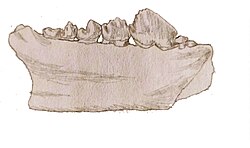 |
| Chiromyoides | C. caesor | Hell's Half Acre (UCM locality 78009), Mesa County, Colorado.[8] | A single upper incisor (UCM 53515).[8] | A plesiadapid. | ||
| C. gigas | Piceance Creek Basin, Colorado.[8] | Multiple teeth.[8] | A plesiadapid. | |||
| C. sp. | UCM locality 78060, Colorado.[8] | A left molar (UCM 41606).[8] | A plesiadapid. | |||
| Elphidotarsius | E. shotgunensis | Wind River Basin, Wyoming.[7] | Shotgun Member.[7] | Right ramus of mandible & isolated teeth.[7] | A carpolestid. | |
| Nannodectes | N. gazini | Fremont County, Colorado.[8] | A right maxilla (USGS 16872).[8] | A plesiadapid. | ||
| Palaechthon | P., near P. alticuspis | Wind River Basin, Wyoming.[7] | Shotgun Member.[7] | 3 upper molars & 4 lower molars.[7] | A plesiadapiform. | |
| P. woodi | Wind River Basin, Wyoming.[7] | Shotgun Member.[7] | A lower jaw & 13 isolated teeth.[7] | A plesiadapiform. | ||
| Palenochtha | P. cf. minor | Wind River Basin, Wyoming.[7] | Shotgun Member.[7] | 5 lower teeth.[7] | A plesiadapiform. | |
| Paromomys | P., near P. depressidens | Wind River Basin, Wyoming.[7] | Shotgun Member.[7] | Approximately 12 upper teeth, 8 isolated lower teeth & a jaw fragment.[7] | A paromomyid. | |
| Phenacolemur | P. fremontensis | Wind River Basin, Wyoming.[7] | Shotgun Member.[7] | A lower jaw & isolated teeth.[7] | A paromomyid. | |
| P. cf. frugivorus | Wind River Basin, Wyoming.[7] | Shotgun Member.[7] | 2 upper molars & 8 isolated lower molars.[7] | A paromomyid. | ||
| Plesiadapis | P. dubius | Piceance Creek Basin, Colorado.[8] | Jaw elements & teeth.[8] | A plesiadapid. |  | |
| P. fodinatus | Piceance Creek Basin, Colorado.[8] | Jaw elements & teeth.[8] | A plesiadapid. | |||
| P. sp. | Wind River Basin, Wyoming.[7] | Shotgun Member.[7] | 5 lower molars, 3 anterior upper molars & a premolar.[7] | A plesiadapid. |  | |
| Plesiolestes | P. cf. problematicus | Wind River Basin, Wyoming.[7] | Shotgun Member.[7] | Approximately 45 isolated teeth.[7] | A plesiadapiform. | |
| Pronothodectes | P. intermedius | Wind River Basin, Wyoming.[7] | Shotgun Member.[7] | Jaw elements & teeth.[7] | A plesiadapid. | |
| Purgatorius | P. janisae | 'Harley's Point’ UCMP locality V77087, Garfield County, Montana.[9] | Tullock Member.[9] | UCMP 150018 (right m1), and UCMP 192398 (left m3).[9] | A purgatoriid. | |
| P. mckeeveri | Garfield County, Montana.[9] | Tullock Member.[9] | Dentary remains & teeth.[9] | A purgatoriid. | ||
| P. cf. P. mckeeveri | Harley's Point’ UCMP locality V77087, Garfield County, Montana.[9] | Tullock Member.[9] | UCMP 150019 (right M2), and UCMP 150020 (right M2).[9] | A purgatoriid. | ||
| Torrejonia | Cf. T. wilsoni | Wind River Basin, Wyoming.[7] | Shotgun Member.[7] | About 14 lower teeth & possibly 3 upper molars.[7] | A plesiadapiform. | |
| Zanycteris | Z. honeyi | UMC locality number 92177, Colorado.[10] | Atwell Gulch Member.[10] | Right maxilla (UCM 87378).[10] | A plesiadapiform. | |
Ungulates
| Ungulates reported from the Fort Union Formation | ||||||
|---|---|---|---|---|---|---|
| Genus | Species | Locality | Stratigraphic member | Material | Notes | Images |
| Dissacus | D. argenteus | Princeton Quarry, Park County, Wyoming.[11] | Upper part of the formation.[11] | Jaw elements & teeth.[11] | A mesonychid. | |
| D. cf. navajovius | Princeton Quarry, Park County, Wyoming.[11] | Upper part of the formation.[11] | Jaw elements & teeth.[11] | Specimens reassigned to D. argenteus. | ||
| D. praenuntius | Park County, Wyoming.[11] | Upper part of the formation.[11] | Mandible (YPM-PU 16159).[11] | A mesonychid also known from the Willwood Formation. | ||
| Ectocion | E. mediotuber | Princeton Quarry, Wyoming.[12] | Dentary.[12] | A phenacodontid. | ||
| Periptychus | P. carinidens | Makoshika State Park, Montana.[13] | A periptychid also found in the Nacimiento, North Horn, Black Peaks & Animas formations. |  | ||
| Sigynorum | S. magnadivisus | Great Divide Basin, southern Wyoming.[14] | China Butte Member.[14] | An arctocyonid. | ||
Reptiles
Birds
A partial ornithurine coracoid bone found in this formation is identical to others found in the older Hell Creek Formation. At present, this unnamed species is the only known individual bird species that have survived the Cretaceous–Paleogene extinction event.[15]
| Birds reported from the Fort Union Formation | ||||||
|---|---|---|---|---|---|---|
| Genus | Species | Locality | Stratigraphic member | Material | Notes | Images |
| Lithornis | L. celetius | Bangtail Quarry, Sedan Quadrangle, Park County, Montana.[16] | A lithornithid. | 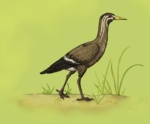 | ||
Crocodilians
| Crocodilians reported from the Fort Union Formation | ||||||
|---|---|---|---|---|---|---|
| Genus | Species | Location | Stratigraphic member | Material | Notes | Images |
| Allognathosuchus | A. sp. | Princeton Quarry, Park County, Wyoming.[17] | Anterior end of left dentary (PU 16988).[17] | A crocodilian. | 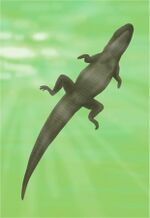 | |
Squamates
| Squamates reported from the Fort Union Formation | ||||||
|---|---|---|---|---|---|---|
| Genus | Species | Locality | Stratigraphic member | Material | Notes | Images |
| Anguidae | Genus & species indeterminate | Swain Quarry, Carbon County, Wyoming.[18] | Fragmentary jaw elements.[18] | An anguid lizard. | ||
| cf. Anguidae | Swain Quarry, Carbon County, Wyoming.[18] | 6 partial dentaries.[18] | Provisionally referred to anguid lizards based on size & shape. | |||
| Contogenys | cf. C. sloani | Swain Quarry, Carbon County, Wyoming.[18] | Posterior part of a right maxilla (AMNH 12069).[18] | A skink. | ||
| Exostinus | E. cf. E. lancensis | Swain Quarry, Carbon County, Wyoming.[18] | 4 partial dentaries.[18] | A xenosaurid lizard. | ||
| E. rugosus | Princeton & Schaff quarries, Park County, Wyoming.[17] | Multiple specimens.[17] | A xenosaurid lizard. | |||
| Glyptosaurinae | Genus & species indeterminate | Swain Quarry, Carbon County, Wyoming.[18] | Several jaw remains.[18] | A glyptosaurine lizard. | ||
| Glyptosaurinae or Odaxosaurinae | Genus & species indeterminate | Swain Quarry, Carbon County, Wyoming.[18] | Fragmentary jaw elements & osteoderms.[18] | Indeterminate lizard remains. | ||
| Machaerosaurus | M. torrejonensis | Swain Quarry, Carbon County, Wyoming.[18] | Numerous jaw elements.[18] | An anguid lizard also known from the Nacimiento Formation. | ||
| Odaxosaurus | O. piger | Swain Quarry, Carbon County, Wyoming.[18] | Many fragmentary jaw remains.[18] | An anguid lizard. | ||
| Oligodontosaurus | O. wyomingensis | Park County, Wyoming.[17] | A left mandible (PU 14246).[17] | An amphisbaenian. | ||
| Palaeosaniwa | cf. P. canadensis | Swain Quarry, Carbon County, Wyoming.[18] | Medial part of left dentary (AMNH 15957).[18] | A large anguimorph lizard. | ||
| Palaeoxantusia | P. fera | Swain Quarry, Carbon County, Wyoming.[18] | Numerous jaw elements.[18] | A night lizard. | ||
| Pancelosaurus | P. piger | Princeton, Fritz & Schaff quarries, Park County, Wyoming.[17] | Multiple skull elements.[17] | An anguid lizard. | ||
| Provaranosaurus | P. acutus | Princeton Quarry, Park County, Wyoming.[17] | PU 14243 (left maxilla), 14561 (anterior portion of left dentary) & 17145 ( fragment of left maxilla).[17] | A palaeovaranid lizard. | ||
| cf. P. sp. | Swain Quarry, Carbon County, Wyoming.[18] | 3 partial dentaries (AMNH 14306, 14307 & 14309).[18] | A palaeovaranid lizard. | |||
| Rhineuridae | Unidentified genus & species | Fritz Quarry, Park County, Wyoming.[17] | An almost complete right dentary & a broken vertebra (PU 18627).[17] | An amphisbaenian. | ||
| Saniwa | cf. S. sp. | Swain Quarry, Carbon County, Wyoming.[18] | 2 trunk vertebrae (AMNH 15960 & 16003).[18] | A varanid. | ||
| Swainiguanoides | S. milleri | Swain Quarry, Carbon County, Wyoming.[18] | Jaw elements.[18] | An iguanid. | ||
Testudines
| Testudines reported from the Fort Union Formation | ||||||
|---|---|---|---|---|---|---|
| Genus | Species | Locality | Stratigraphic member | Material | Notes | Images |
| Atoposemys | A. entopteros | Montana.[19] | Tullock Member.[19] | A softshell turtle. | ||
| Axestemys | A. montinsana | PTRM Site V02017, Slope County, North Dakota.[20] | Numerous skull, limb & shell fragments.[20] | A softshell turtle also found in the Melville & Denver formations. | ||
| Cardiochelyon | C. rogerwoodi | Reis Quarry, Park County, Wyoming.[21] | Partial skeleton (YPM PU14671).[21] | A kinosternoid formerly thought to be a platysternid. | ||
| Cedrobaena | C. putorius | Cedar Point Quarry, Wyoming.[22] | Shell & skull elements.[22] | A baenid turtle also found in the Hell Creek Formation. | 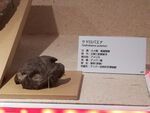 | |
| Hutchemys | H. arctochelys | Burns Mine, Washoe Area, Carbon County, Montana.[23] | Tongue River Member.[23] | Multiple shell elements.[23] | A softshell turtle. | |
| H. rememdium | Fallon County, Montana.[23] | Ekalaka Member.[23] | A near complete postcranial skeleton (YPM PU 16795) & shell elements.[23] | A softshell turtle. | ||
| H. sp. | Duffy's Ranch, Sweet Grass County, Montana.[23] | YPM PU 11566.[23] | A softshell turtle. | |||
| Ptychogaster | P. sp. | Princeton Quarry & Reiss Locality, Park County, Wyoming.[17] | PU 17794 (fragments of the skull & shell), 14671 & 16443 (shells).[17] | A turtle. | ||
| Tullochelys | T. montanus | Montana.[19] | Tullock Member.[19] | A chelydrid turtle also known from the Hell Creek Formation. | ||
Amphibians
| Amphibians reported from the Fort Union Formation | ||||||
|---|---|---|---|---|---|---|
| Genus | Species | Locality | Stratigraphic member | Material | Notes | Images |
| Amphiuma | A. jepseni | Park County, Wyoming.[17] | PU 14666 (partial vertebral column), 14668 (partial skull) & 16788 (dislocated vertebrae).[17] | An aquatic salamander. | ||
| Anura | Incertae sedis | Park County, Wyoming.[17] | PU 14662 (distal end of right radioulna), 14663 (proximal end of left radioulna), 14669 (phalanx), 13372 (right maxilla).[17] | A frog. | ||
| Discoglossidae | Undescribed genus & species | Park County, Wyoming.[17] | Distal end of right humerus (PU 14670).[17] | A frog similar to undescribed discoglossid remains from the Hell Creek Formation.[17] | ||
| Eorhinophrynus | E. sp. | Princeton & Fritz quarries, Park County, Wyoming.[17] | Humeri & vertebrae.[17] | A burrowing toad. | ||
| Opisthotriton | O. kayi | Princeton Quarry, Park County, Wyoming.[17] | Multiple specimens.[17] | A salamander. | ||
| Scapherpeton | S. tectum | Princeton & Schaff quarries, Park County, Wyoming.[17] | PU 20583 (3 broken vertebrae, an atlas, an ilium & a rib) & PU 19500 (a humerus).[17] | A salamander. |  | |
Fish
| Fish reported from the Fort Union Formation | ||||||
|---|---|---|---|---|---|---|
| Genus | Species | Locality | Stratigraphic member | Material | Notes | Images |
| Acipenseridae | Morphotype A | Eagle Mine near Bear Creek, Carbon County, Montana.[24] | A complete lateral scute (YPM VPPU 17066).[24] | A large sturgeon. | ||
| Morphotype B | Highway Blowout Site, Fallon County, Montana.[24] | Tongue River Member.[24] | A complete lateral scute (YPM VPPU 16646).[24] | A large sturgeon. | ||
| Amia | A. fragosa | Schaff Quarry, Park County, Wyoming.[17] | 3 vertebral centra (PU 21174).[17] | A bowfin. | ||
| Atractosteus | A. grandei | Bowman County, North Dakota.[25] | Lowest Danian strata.[25] | A large gar. | ||
| Engdahlichthys | E. milviaegis | Montana.[26] | Tullock Member.[26] | A fairly small sturgeon. | ||
| Polyodon | P. tuberculata | Montana.[26] | Tullock Member.[26] | 3 specimens.[26] | A paddlefish. | |
Invertebrates
Bivalves
| Bivalves reported from the Fort Union Formation | ||||||
|---|---|---|---|---|---|---|
| Genus | Species | Locality | Stratigraphic member | Material | Notes | Images |
| Pisidium | P. sp. indet. | Powder River Basin.[27] | Tongue River Member.[27] | 8 specimens.[27] | A sphaeriid. | |
| P.? sp. indet. | Powder River Basin.[27] | Tongue River Member.[27] | 3 specimens.[27] | A sphaeriid. | ||
| Plesielliptio | P. priscus | Powder River Basin.[27] | Tongue River Member.[27] | Numerous specimens.[27] | A unionid. | |
| cf. P. priscus | Powder River Basin.[27] | Tongue River Member.[27] | Several specimens.[27] | A unionid. | ||
| P. silberlingi | Powder River Basin.[27] | Tongue River Member.[27] | Numerous specimens.[27] | A unionid. | ||
| cf. P. silberlingi | Powder River Basin.[27] | Tongue River Member.[27] | 6 specimens.[27] | A unionid. | ||
| P. sp. indet. | Powder River Basin.[27] | Tongue River Member.[27] | 2 specimens.[27] | A unionid. | ||
| Sphaeriidae | Gen. & sp. indet. | Powder River Basin.[27] | Tongue River Member.[27] | Numerous specimens.[27] | A sphaeriid. | |
| Sphaerium | S. sp. indet. | Powder River Basin.[27] | Tongue River Member.[27] | 1 specimen.[27] | A sphaeriid. | |
| S.? sp. indet. | Powder River Basin.[27] | Tongue River Member.[27] | Several specimens.[27] | A sphaeriid. | ||
| Unionidae | Gen. & sp. indet. | Powder River Basin.[27] | Tongue River Member.[27] | 11 specimens.[27] | A unionid. | |
Gastropods
| Gastropods reported from the Fort Union Formation | ||||||
|---|---|---|---|---|---|---|
| Genus | Species | Locality | Stratigraphic member | Material | Notes | Images |
| Acroloxus | A.? minutus | Powder River Basin.[27] | Tongue River Member.[27] | 2 specimens.[27] | A river limpet. | |
| A. sp. indet. | Powder River Basin.[27] | Tongue River Member.[27] | 1 specimen.[27] | A river limpet. | ||
| Clenchiella | C. n. sp. A | Powder River Basin.[27] | Tongue River Member.[27] | Numerous specimens.[27] | A clenchiellid. | |
| C. n. sp. A? | Powder River Basin.[27] | Tongue River Member.[27] | 1 specimen.[27] | A clenchiellid. | ||
| C. cf. C. n. sp. A | Powder River Basin.[27] | Tongue River Member.[27] | 10 specimens.[27] | A clenchiellid. | ||
| C. sp. indet. | Powder River Basin.[27] | Tongue River Member.[27] | 30 specimens.[27] | A clenchiellid. | ||
| Hydrobia | H. anthonyi | Powder River Basin.[27] | Tongue River Member.[27] | 2 specimens.[27] | A hydrobiid. | |
| H. sp. A | Powder River Basin.[27] | Tongue River Member.[27] | Numerous specimens.[27] | A hydrobiid. | ||
| H. cf. H. sp. A | Powder River Basin.[27] | Tongue River Member.[27] | 2 specimens.[27] | A hydrobiid. | ||
| H. sp. B? | Powder River Basin.[27] | Tongue River Member.[27] | Multiple specimens.[27] | A hydrobiid. | ||
| H. sp. C? | Powder River Basin.[27] | Tongue River Member.[27] | 1 specimen.[27] | A hydrobiid. | ||
| H. sp. indet. | Powder River Basin.[27] | Tongue River Member.[27] | Multiple specimens.[27] | A hydrobiid. | ||
| H.? sp. indet. | Powder River Basin.[27] | Tongue River Member.[27] | 2 specimens.[27] | A hydrobiid. | ||
| Lioplacodes | L. multistriata | Powder River Basin.[27] | Tongue River Member.[27] | Numerous specimens.[27] | A viviparid. | |
| L. tenuicarinata | Powder River Basin.[27] | Tongue River Member.[27] | Numerous specimens.[27] | A viviparid. | ||
| L. tenuicarinata? | Powder River Basin.[27] | Tongue River Member.[27] | 11 specimens.[27] | A viviparid. | ||
| L. limneaformis | Powder River Basin.[27] | Tongue River Member.[27] | Numerous specimens.[27] | A viviparid. | ||
| L. sp. indet. | Powder River Basin.[27] | Tongue River Member.[27] | Numerous specimens.[27] | A viviparid. | ||
| L.? sp. indet. | Powder River Basin.[27] | Tongue River Member.[27] | 1 specimen.[27] | A viviparid. | ||
| Valvata? | V.? sp. indet. | Powder River Basin.[27] | Tongue River Member.[27] | 1 specimen.[27] | A valvatid. | |
| Viviparus | V. raynoldsanus | Powder River Basin.[27] | Tongue River Member.[27] | Numerous specimens.[27] | A viviparid. | |
| V. raynoldsanus? | Powder River Basin.[27] | Tongue River Member.[27] | 1 specimen.[27] | A viviparid. | ||
| V. cf. V. raynoldsanus | Powder River Basin.[27] | Tongue River Member.[27] | 17 specimens.[27] | A viviparid. | ||
| V. sp. | Powder River Basin.[27] | Tongue River Member.[27] | Multiple specimens.[27] | A viviparid. | ||
Plants
| Plants reported from the Fort Union Formation | ||||||
|---|---|---|---|---|---|---|
| Genus | Species | Locality | Stratigraphic member | Material | Notes | Images |
| Aesculus | A. hickeyi | Custer National Forest, Powder River County, Montana.[28] | Tongue River Member.[28] | Leaves.[28] | A horse chestnut. | |
| Amersinia | A. obtrullata | Custer National Forest, Powder River County, Montana.[28] | Tongue River Member.[28] | Fruits.[28] | A nyssaceaen, may be produced by the same plant as Beringiaphyllum cupanioides. | |
| Beringiaphyllum | B. cupanioides | Custer National Forest, Powder River County, Montana.[28] | Tongue River Member.[28] | Leaf (UF 18969-60464).[28] | A nyssaceaen, may be produced by the same plant as Amersinia obtrullata. | |
| Browniea | B. serrata | Mexican Hat locality & Custer National Forest, Powder River County, Montana.[28][29] | Lebo Member & Tongue River Member.[28][29] | Leaves showing signs of insect damage.[29] | A nyssaceaen. | |
| Cercidiphyllum | C. genetrix | Mexican Hat locality, Montana.[29] | Lebo Member.[29] | Leaves showing signs of insect damage.[29] | A katsura tree. | |
| Cornus | C. swingii | Custer National Forest, Powder River County, Montana.[28] | Tongue River Member.[28] | Leaves.[28] | A dogwood. | |
| Davidia | D. antiqua | Custer National Forest, Powder River County, Montana.[28] | Tongue River Member.[28] | Leaves & fruits.[28] | A dove tree. | |
| Cf. Dennstaedtia | Cf. D. americana | Custer National Forest, Powder River County, Montana.[28] | Tongue River Member.[28] | A single specimen of sterile foliage (UF 18969-34532).[28] | A fern. | |
| Dicotylophyllum | D. hansonium | Williston Basin, North Dakota.[30] | Tongue River Member.[30] | Leaves.[30] | A dicot. | |
| D. horsecreekium | Williston Basin, North Dakota.[30] | Ludlow Member.[30] | Leaves.[30] | A dicot. | ||
| Eostangeria | E. pseudopteris | Sweetwater County, Wyoming.[31] | Upper part of the formation.[31] | Multiple specimens.[31] | A cycad. | |
| Equisetum | E. sp. | Custer National Forest, Powder River County, Montana.[28] | Tongue River Member.[28] | A single stem (UF 18969-60476A).[28] | A horsetail. | |
| "Ficus" | "F." artocarpoides | Mexican Hat locality.[29] | Lebo Member.[29] | Leaves with signs of hole feeding and insect mining.[29] | A fig-tree. | |
| Glyptostrobus | G. europaeus | Mexican Hat locality.[29] | Lebo Member.[29] | Leafy branches.[29] | A conifer. | |
| Juglandiphyllites | J. glabra | Mexican Hat locality, Montana.[29] | Lebo Member.[29] | Leaves with insect damage and probable lepidopteran leaf mines.[29] | A member of the walnut family. | |
| Lauraceae | Species 1 | Mexican Hat locality, Montana.[29] | Lebo Member.[29] | Leaf with piercing and sucking marks from insects.[29] | ||
| Species 2 | Mexican Hat locality, Montana.[29] | Lebo Member.[29] | Leaves showing signs of insect damage.[29] | |||
| Macginistemon | M. mikanoides | Custer National Forest, Powder River County, Montana.[28] | Tongue River Member.[28] | Stamen groups.[28] | A platanaceaen. | |
| Macginitiea | M. gracilis | Custer National Forest, Powder River County, Montana.[28] | Tongue River Member.[28] | A fragmentary leaf (UF 18969-38380).[28] | A platanaceaen. | |
| M. nascens | Williston Basin, North Dakota.[30] | Ludlow Member.[30] | Leaves.[30] | A platanaceaen. | ||
| Meliosma | M. thriviensis | Williston Basin, North Dakota.[30] | Ludlow Member.[30] | Leaves.[30] | A sabiaceaen. | |
| M. vandaelium | Williston Basin, North Dakota.[30] | Tongue River Member.[30] | Multiple leaves.[30] | A sabiaceaen. | ||
| Nordenskioeldia | N. borealis | Custer National Forest, Powder River County, Montana.[28] | Tongue River Member.[28] | Fruit.[28] | A trochodendrale. | |
| Paleonelumbo | P. macroloba | Mexican Hat locality, Montana.[29] | Lebo Member.[29] | Leaves.[29] | A nelumbonaceaen. | |
| Paranymphaea | P. crassifolia | Mexican Hat locality, Montana.[29] | Lebo Member.[29] | Leaves.[29] | A nymphaeaceaen. | |
| Phyllites | P. demoresii | Custer National Forest, Powder River County, Montana.[28] | Tongue River Member.[28] | Leaves.[28] | ||
| Platanus | P. raynoldsii | Mexican Hat locality, Montana.[29] | Lebo Member.[29] | Leaves showing signs of insect damage.[29] | A plane-tree. | |
| P. sp. | Custer National Forest, Powder River County, Montana.[28] | Tongue River Member.[28] | Leaves.[28] | A plane-tree. | ||
| Polyptera | P. manningii | Mexican Hat locality, Montana.[29] | Lebo Member.[29] | Fruits.[29] | A member of the walnut family. | |
| "Populus" | "P". nebrascensis | Mexican Hat locality, Montana.[29] | Lebo Member.[29] | Leaves showing signs of insect damage.[29] | A poplar. | |
| Porosia | P. verrucosa | Custer National Forest, Powder River County, Montana.[28] | Tongue River Member.[28] | Fruits.[28] | A rutaceaen. | |
| Taxodium | T. olrikii | Custer National Forest, Powder River County, Montana.[28] | Tongue River Member.[28] | [28] | A cypress tree. | |
| Ternstromites | cf. T. aureavallis | Mexican Hat locality, Montana.[29] | Lebo Member.[29] | Leaf with a gall at the intersection of primary and secondary veins.[29] | A theaceaen. | |
| T. paucimissouriensis | Williston Basin, North Dakota.[30] | Ludlow & Tongue River Members.[30] | Leaves.[30] | A theaceaen. | ||
| Trochodendroides | T. genetrix | Custer National Forest, Powder River County, Montana.[28] | Tongue River Member.[28] | A few leaves.[28] | A saxifrage. | |
| Ulmites | U. microphylla | Custer National Forest, Powder River County, Montana.[28] | Tongue River Member.[28] | Leaves.[28] | An ulmaceaen. | |
| Zizyphoides | Z. flabella | Mexican Hat locality, Montana & Custer National Forest, Powder River County, Montana.[29][28] | Lebo Member & Tongue River Member.[29][28] | Leaves showing signs of insect damage.[29] | A trochodendrale. | |
See also
- List of fossiliferous stratigraphic units in Colorado
- List of fossiliferous stratigraphic units in Montana
- List of fossiliferous stratigraphic units in North Dakota
- List of fossiliferous stratigraphic units in Wyoming
- Uranium mining in Wyoming
- Guaduas Formation, contemporaneous coal-bearing formation of northern South America
References
- ↑ 1.0 1.1 Wyodak Coal, Tongue River Member of the Fort Union Formation, Powder River Basin, Wyoming: "No-Coal Zones" and Their Effects on Coalbed Methane Production, by Mark Ashley, 2005
- ↑ Eocene and Paleocene rocks of the southern and central basins, by Robert E. McDonald, in Geologic Atlas of the Rocky Mountain Region, Rocky Mountain Association of Geologists, Denver, CO, 1972: p. 248
- ↑ Cretaceous and Tertiary coals of the Rocky Mountains and Great Plains regions, by R.M. Flores and T.A. Cross, 1991, in Economic Geology, U.S., Geological Society of America, Decade of North American Geology Series, vol. P-2, p. 547-571.
- ↑ 4.0 4.1 4.2 Clemens, William A. (2018-02-17). "A pantodont (Mammalia) from the latest Puercan North American Land Mammal Age (earliest Paleocene) of the Western Interior, USA". Historical Biology 30 (1–2): 183–188. doi:10.1080/08912963.2016.1276178. ISSN 0891-2963. https://doi.org/10.1080/08912963.2016.1276178.
- ↑ 5.0 5.1 5.2 Clemens, W. (January 9, 2015). "(Leptictidae, Mammalia) from the Tullock Member of the Fort Union Formation, Garfield and McCone Counties, Montana, USA" (in en). PaleoBios 32 (1): 1–17. doi:10.5070/P9321025382.
- ↑ 6.0 6.1 6.2 6.3 Johanson, Zerina (November 1996). "New marsupial from the Fort Union Formation, Swain Quarry, Wyoming" (in en). Journal of Paleontology 70 (6): 1023–1031. doi:10.1017/S0022336000038725. ISSN 0022-3360. Bibcode: 1996JPal...70.1023J. https://www.cambridge.org/core/journals/journal-of-paleontology/article/abs/new-marsupial-from-the-fort-union-formation-swain-quarry-wyoming/32D033CDFC2A42D61645C86AE4B1E5C1.
- ↑ 7.00 7.01 7.02 7.03 7.04 7.05 7.06 7.07 7.08 7.09 7.10 7.11 7.12 7.13 7.14 7.15 7.16 7.17 7.18 7.19 7.20 7.21 7.22 7.23 7.24 7.25 7.26 7.27 7.28 7.29 7.30 7.31 7.32 7.33 7.34 7.35 Gazin, C. Lewis (1971). "Paleocene primates from the shotgun member of the Fort Union Formation in the Wind River Basin, Wyoming". Proceedings of the Biological Society of Washington 84: 13–37. ISSN 0006-324X. https://www.biodiversitylibrary.org/part/44304.
- ↑ 8.00 8.01 8.02 8.03 8.04 8.05 8.06 8.07 8.08 8.09 8.10 8.11 Burger, Benjamin J.; Honey, James G. (2008-09-12). "Plesiadapidae (Mammalia, Primates) from the late Paleocene Fort Union Formation of the Piceance Creek Basin, Colorado". Journal of Vertebrate Paleontology 28 (3): 816–825. doi:10.1671/0272-4634(2008)28[816:pmpftl2.0.co;2]. ISSN 0272-4634. https://www.researchgate.net/publication/232670200.
- ↑ 9.0 9.1 9.2 9.3 9.4 9.5 9.6 9.7 9.8 Wilson Mantilla, Gregory P.; Chester, Stephen G. B.; Clemens, William A.; Moore, Jason R.; Sprain, Courtney J.; Hovatter, Brody T.; Mitchell, William S.; Mans, Wade W. et al. (2021). "Earliest Palaeocene purgatoriids and the initial radiation of stem primates". Royal Society Open Science 8 (2): 210050. doi:10.1098/rsos.210050. ISSN 2054-5703. PMID 33972886. Bibcode: 2021RSOS....810050W.
- ↑ 10.0 10.1 10.2 Burger, Benjamin John (2013-10-29). "A new species of the archaic primate Zanycteris from the late Paleocene of western Colorado and the phylogenetic position of the family Picrodontidae". PeerJ 1: e191. doi:10.7717/peerj.191. ISSN 2167-8359. PMID 24255808.
- ↑ 11.0 11.1 11.2 11.3 11.4 11.5 11.6 11.7 11.8 O'Leary, Maureen A.; Rose, Kenneth D. (1995-05-12). "New mesonychian dentitions from the Paleocene and Eocene of the Bighorn Basin, Wyoming". Annals of the Carnegie Museum 64 (2): 147–172. doi:10.5962/p.215127. ISSN 0097-4463. https://www.biodiversitylibrary.org/part/215127.
- ↑ 12.0 12.1 Thewissen, J. G. M. (1990) (in en-US). Evolution of Paleocene and Eocene Phenacodontidae (Mammalia, Condylarthra). http://deepblue.lib.umich.edu/handle/2027.42/48629.
- ↑ Shelley, Sarah L.; Williamson, Thomas E.; Brusatte, Stephen L. (2018-07-18). "The osteology of Periptychus carinidens: A robust, ungulate-like placental mammal (Mammalia: Periptychidae) from the Paleocene of North America" (in en). PLOS ONE 13 (7): e0200132. doi:10.1371/journal.pone.0200132. ISSN 1932-6203. PMID 30020948. Bibcode: 2018PLoSO..1300132S.
- ↑ 14.0 14.1 McComas, Katie M.; Eberle, Jaelyn J. (May 2015). "A new earliest Paleocene (Puercan) arctocyonid mammal from the Fort Union Formation, Great Divide Basin, Wyoming, and its phylogenetic position among early 'condylarths'". Journal of Systematic Palaeontology 14 (6): 445–459. doi:10.1080/14772019.2015.1066886. https://www.tandfonline.com/doi/abs/10.1080/14772019.2015.1066886?cookieSet=1.
- ↑ Longrich, N.R., Tokaryk, T. and Field, D.J. (2011). "Mass extinction of birds at the Cretaceous–Paleogene (K–Pg) boundary." Proceedings of the National Academy of Sciences, 108(37): 15253-15257. doi:10.1073/pnas.1110395108
- ↑ Houde, Peter W. (1988). "Paleognathous Birds from the Early Tertiary of the Northern Hemisphere". The Auk 107 (2): 455–456. doi:10.2307/4087644. ISSN 0004-8038. http://dx.doi.org/10.2307/4087644.
- ↑ 17.00 17.01 17.02 17.03 17.04 17.05 17.06 17.07 17.08 17.09 17.10 17.11 17.12 17.13 17.14 17.15 17.16 17.17 17.18 17.19 17.20 17.21 17.22 17.23 17.24 17.25 17.26 17.27 17.28 Estes, Richard (1975). "Lower Vertebrates from the Fort Union Formation, Late Paleocene, Big Horn Basin, Wyoming". Herpetologica 31 (4): 365–385. ISSN 0018-0831. https://www.jstor.org/stable/3891523.
- ↑ 18.00 18.01 18.02 18.03 18.04 18.05 18.06 18.07 18.08 18.09 18.10 18.11 18.12 18.13 18.14 18.15 18.16 18.17 18.18 18.19 18.20 18.21 18.22 18.23 18.24 18.25 Sullivan, Robert M. (January 1982). "Fossil lizards from Swain Quarry "Fort Union Formation," middle Paleocene (Torrejonian), Carbon County, Wyoming". Journal of Paleontology 56 (4): 996–1010. https://www.researchgate.net/publication/289505965.
- ↑ 19.0 19.1 19.2 19.3 Hutchison, J. Howard (2013), Brinkman, Donald B.; Holroyd, Patricia A.; Gardner, James D., eds., "New Turtles from the Paleogene of North America" (in en), Morphology and Evolution of Turtles, Vertebrate Paleobiology and Paleoanthropology (Dordrecht: Springer Netherlands): pp. 477–497, doi:10.1007/978-94-007-4309-0_26, ISBN 978-94-007-4309-0, https://doi.org/10.1007/978-94-007-4309-0_26, retrieved 2022-11-19
- ↑ 20.0 20.1 Vitek, Natasha S. (2012-03-11). "Giant fossil soft-shelled turtles of North America" (in English). Palaeontologia Electronica 15 (16): 1–43. doi:10.26879/299. ISSN 1094-8074. https://palaeo-electronica.org/content/2012-issue-1-articles/210-giant-soft-shelled-turtles.
- ↑ 21.0 21.1 Joyce, Walter G.; Claude, Julien (2020-01-15). "An alternative interpretation of the Paleogene turtle Cardichelyon rogerwoodi as a hinged kinosternoid". Journal of Paleontology 94 (3): 557–567. doi:10.1017/jpa.2019.92. ISSN 0022-3360. Bibcode: 2020JPal...94..557J.
- ↑ 22.0 22.1 Lyson, Tyler R.; Joyce, Walter G. (November 2009). "A revision of Plesiobaena (Testudines: Baenidae) and an assessment of baenid ecology across the K/T boundary" (in en). Journal of Paleontology 83 (6): 833–853. doi:10.1666/09-035.1. ISSN 0022-3360. https://www.researchgate.net/publication/228491454.
- ↑ 23.0 23.1 23.2 23.3 23.4 23.5 23.6 23.7 Joyce, Walter G.; Revan, Ariel; Lyson, Tyler R.; Danilov, Igor G. (2009). "Two New Plastomenine Softshell Turtles from the Paleocene of Montana and Wyoming". Bulletin of the Peabody Museum of Natural History 50 (2): 307. doi:10.3374/014.050.0202. ISSN 0079-032X. https://www.academia.edu/en/2380203/Two_new_plastomenine_softshell_turtles_from_the_Paleocene_of_Montana_and_Wyoming.
- ↑ 24.0 24.1 24.2 24.3 24.4 Brownstein, Chase Doran (November 2022). "Evidence of large sturgeons in the Paleocene of North America" (in en). Journal of Paleontology 97: 218–222. doi:10.1017/jpa.2022.87. ISSN 0022-3360.
- ↑ 25.0 25.1 Brownstein, Chase Doran; Lyson, Tyler R. (2022). "Giant gar from directly above the Cretaceous–Palaeogene boundary suggests healthy freshwater ecosystems existed within thousands of years of the asteroid impact". Biology Letters 18 (6): 20220118. doi:10.1098/rsbl.2022.0118. PMID 35702983.
- ↑ 26.0 26.1 26.2 26.3 26.4 Murray, Alison M.; Brinkman, Donald B.; DeMar, David G.; Wilson, Gregory P. (2020-03-03). "Paddlefish and sturgeon (Chondrostei: Acipenseriformes: Polyodontidae and Acipenseridae) from lower Paleocene deposits of Montana, U.S.A.". Journal of Vertebrate Paleontology 40 (2): e1775091. doi:10.1080/02724634.2020.1775091. ISSN 0272-4634. Bibcode: 2020JVPal..40E5091M. https://doi.org/10.1080/02724634.2020.1775091.
- ↑ 27.000 27.001 27.002 27.003 27.004 27.005 27.006 27.007 27.008 27.009 27.010 27.011 27.012 27.013 27.014 27.015 27.016 27.017 27.018 27.019 27.020 27.021 27.022 27.023 27.024 27.025 27.026 27.027 27.028 27.029 27.030 27.031 27.032 27.033 27.034 27.035 27.036 27.037 27.038 27.039 27.040 27.041 27.042 27.043 27.044 27.045 27.046 27.047 27.048 27.049 27.050 27.051 27.052 27.053 27.054 27.055 27.056 27.057 27.058 27.059 27.060 27.061 27.062 27.063 27.064 27.065 27.066 27.067 27.068 27.069 27.070 27.071 27.072 27.073 27.074 27.075 27.076 27.077 27.078 27.079 27.080 27.081 27.082 27.083 27.084 27.085 27.086 27.087 27.088 27.089 27.090 27.091 27.092 27.093 27.094 27.095 27.096 27.097 27.098 27.099 27.100 27.101 27.102 27.103 27.104 Hanley, John H.; Flores, Romeo M. (1987). "Taphonomy and Paleoecology of Nonmarine Mollusca: Indicators of Alluvial Plain Lacustrine Sedimentation, Upper Part of the Tongue River Member, Fort Union Formation (Paleocene), Northern Powder River Basin, Wyoming and Montana". PALAIOS 2 (5): 479–496. doi:10.2307/3514619. ISSN 0883-1351. Bibcode: 1987Palai...2..479H. https://www.jstor.org/stable/3514619.
- ↑ 28.00 28.01 28.02 28.03 28.04 28.05 28.06 28.07 28.08 28.09 28.10 28.11 28.12 28.13 28.14 28.15 28.16 28.17 28.18 28.19 28.20 28.21 28.22 28.23 28.24 28.25 28.26 28.27 28.28 28.29 28.30 28.31 28.32 28.33 28.34 28.35 28.36 28.37 28.38 28.39 28.40 28.41 28.42 28.43 28.44 28.45 28.46 28.47 28.48 28.49 28.50 28.51 Manchester, Steven R.; Foster, Alyssa; Lott, Terry A. (2023-05-12). "The Paleocene Horse Creek florule, Tongue River Member of the Fort Union Formation, southeastern Montana, USA" (in english). Acta Palaeobotanica 63 (1): 32–53. doi:10.35535/acpa-2023-0003. ISSN 0001-6594. https://acpa.botany.pl/The-Paleocene-Horse-Creek-florule-Tongue-River-Member-of-the-Fort-Union-Formation,162170,0,2.html.
- ↑ 29.00 29.01 29.02 29.03 29.04 29.05 29.06 29.07 29.08 29.09 29.10 29.11 29.12 29.13 29.14 29.15 29.16 29.17 29.18 29.19 29.20 29.21 29.22 29.23 29.24 29.25 29.26 29.27 29.28 29.29 29.30 29.31 29.32 29.33 29.34 29.35 29.36 29.37 29.38 29.39 29.40 29.41 Donovan, Michael P.; Wilf, Peter; Labandeira, Conrad C.; Johnson, Kirk R.; Peppe, Daniel J. (2014-07-24). "Novel Insect Leaf-Mining after the End-Cretaceous Extinction and the Demise of Cretaceous Leaf Miners, Great Plains, USA" (in en). PLOS ONE 9 (7): e103542. doi:10.1371/journal.pone.0103542. ISSN 1932-6203. PMID 25058404. Bibcode: 2014PLoSO...9j3542D.
- ↑ 30.00 30.01 30.02 30.03 30.04 30.05 30.06 30.07 30.08 30.09 30.10 30.11 30.12 30.13 30.14 30.15 30.16 30.17 Peppe, Daniel J.; Hickey, Leo J. (November 2014). "Fort Union Formation Fossil Leaves (Paleocene, Williston Basin, North Dakota, USA) Indicate Evolutionary Relationships Between Paleocene and Eocene Plant Species". Bulletin of the Peabody Museum of Natural History 55 (2): 171–189. doi:10.3374/014.055.0209. ISSN 0079-032X. https://www.researchgate.net/publication/274312501.
- ↑ 31.0 31.1 31.2 Kvaček, Zlatko; Manchester, Steven R. (1999). "Eostangeria Barthel (Extinct Cycadales) from the Paleogene of Western North America and Europe". International Journal of Plant Sciences 160 (3): 621–629. doi:10.1086/314152. ISSN 1058-5893. https://www.researchgate.net/publication/240563782.
 |

